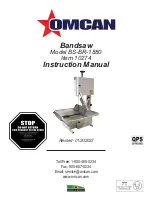
13.2
Disengage the chain brake.
9931BA015 KN
► Pull the hand guard back toward the front han‐
dle (position
‚
).
The chain brake is also activated by the inertia of
the front hand guard if the kickback force of the
saw is high enough: The hand guard is acceler‐
ated toward the bar nose – even if your left hand
is not behind the hand guard, e.g. during a hori‐
zontal cut.
The chain brake will operate only if the hand
guard has not been modified in any way.
13.3
Checking operation of the
chain brake
Before starting work:
► Move hand guard to position
‚
– chain brake
is disengaged.
► Switch on the saw.
► Push the hand guard towards the bar nose
(position
ƒ
).
The chain brake is working properly if the saw
chain comes to a standstill within a few fractions
of a second.
The hand guard must be free from dirt and move
freely.
13.4
Chain brake maintenance
The chain brake is subject to normal wear. It is
necessary to have it serviced and maintained
regularly by trained personnel. STIHL recom‐
mends that you have servicing and repair work
carried out exclusively by an authorized STIHL
servicing dealer. Maintain the following servicing
intervals:
Full-time usage:
every 3 months
Part-time usage:
every 6 months
Occasional usage:
every 12 months
14 Connecting to Power Sup‐
ply
The voltage and frequency of the machine (see
rating plate) must match the voltage and fre‐
quency of the power connection.
The minimum fuse protection of the power con‐
nection must comply with the specifications – see
"Specifications".
The machine must be connected to the power
supply via an earth-leakage circuit breaker to dis‐
connect the power supply if the differential cur‐
rent to earth exceeds 30 mA.
The power connection must correspond to
IEC 60364 and relevant national regulations.
14.1
Extension cord
The design of the extension cord must at least
fulfill the same features as the connecting cord
on the machine. Observe the design marking
(type designation) on the connecting cord.
The cores in the cord must have the following
minimum cross-section depending on the mains
voltage and cord length.
Cord length
Minimum cross-section
220 V – 240 V:
Up to 20 m
1.5 mm
2
20 m to 50 m
2.5 mm
2
100 V – 127 V:
Up to 10 m
AWG 14 / 2.0 mm
2
10 m to 30 m
AWG 12 / 3.5 mm
2
14.2
Connecting to Wall Outlet
► Connect the power tool's plug or the extension
cord's plug to a properly installed wall outlet.
15 Switching On
► Make sure you have a secure and balanced
footing.
► Check that bystanders are well clear of the
general work area of the power tool.
► Hold the power tool firmly with both hands on
the handles.
► Check that the saw chain chain is not touching
the wood or any other object.
14 Connecting to Power Supply
English
0458-764-0121-B
21
















































